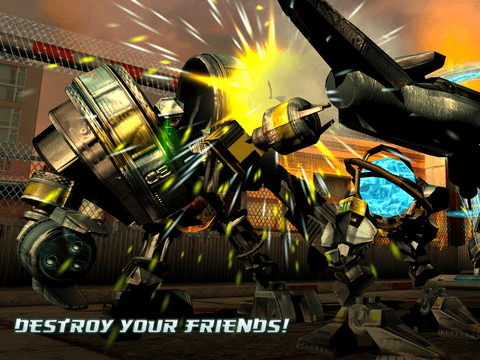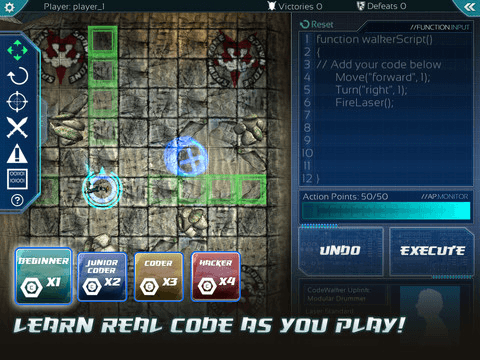- Wondering how to get Monopoly GO! free rolls? Well, you’ve come to the right place. In this guide, we provide you with a bunch of tips and tricks to get some free rolls for the hit new mobile game. We’ll …
Best Roblox Horror Games to Play Right Now – Updated Weekly
By Adele Wilson
Our Best Roblox Horror Games guide features the scariest and most creative experiences to play right now on the platform!The BEST Roblox Games of The Week – Games You Need To Play!
By Sho Roberts
Our feature shares our pick for the Best Roblox Games of the week! With our feature, we guarantee you'll find something new to play!Type Soul Clan Rarity Guide – All Legendary And Common Clans Listed!
By Nathan Ball
Wondering what your odds of rolling a particular Clan are? Wonder no more, with my handy Type Soul Clan Rarity guide.
Hakitzu Elite: Robot Hackers Review
The idea of programming robots and such from within a video game is both cool and daunting. It’s also been done both well and not so well in the past. Hakitzu Elite: Robot Hackers marks another attempt at the concept that’s been simplified for beginners, but also offers more complex options for anyone who really wants to dig in. And it does a surprisingly good job of it – aside from the rough menu UI, anyway.

TurnBased(“mechcombat”,10); RoughInterface();
The idea of programming robots and such from within a video game is both cool and daunting. It’s also been done both well and not so well in the past. Hakitzu Elite: Robot Hackers marks another attempt at the concept that’s been simplified for beginners, but also offers more complex options for anyone who really wants to dig in. And it does a surprisingly good job of it – aside from the rough menu UI, anyway.
Hakitzu Elite: Robot Hackers is, as I’ve said, primarily about programming. There are several coding options available in order to make the gameplay more accessible to a wider range of players, but for the most part, one should expect to use a lot of parenthesis and semicolons. Every task – from moving to turning to fighting to hacking – requires coding and draws from a pool of action points. More complex actions require more points, and once they’re used up, there’s nothing to do but wait for the next turn to come up. This makes strategy, in addition to coming to grips with the game’s basic programming language, very important.
 “ The solo game is essentially a series of brief tutorials that cover the basics, and then a set of puzzle-like challenges to get players used to navigation and combat. Multiplayer, on the other hand, is an entirely different beast. Each player chooses two of their customized mechs – referred to as “Codewalkers” – to toss into battle, and then they each take turns issuing orders (while staying within their action point limits). Ultimately they’ll want to position their bots next to their opponent’s tower and “hack” it three times in order to destroy it and win, but there are benefits to taking out the other mechs as well. Mostly because they’ll be out of the picture for three turns, making hacking a whole lot simpler.
“ The solo game is essentially a series of brief tutorials that cover the basics, and then a set of puzzle-like challenges to get players used to navigation and combat. Multiplayer, on the other hand, is an entirely different beast. Each player chooses two of their customized mechs – referred to as “Codewalkers” – to toss into battle, and then they each take turns issuing orders (while staying within their action point limits). Ultimately they’ll want to position their bots next to their opponent’s tower and “hack” it three times in order to destroy it and win, but there are benefits to taking out the other mechs as well. Mostly because they’ll be out of the picture for three turns, making hacking a whole lot simpler.
As rough as Hakitzu Elite: Robot Hackers‘ models are, and as goofy as its animations can be, I actually really like the overall presentation. It’s fairly easy to figure out a mech’s orientation from the birds-eye strategy view, and seeing the programming window hovering near a bot as it performs its actions (complete with highlights over currently executing commands) is all kinds of neat. There are also a fair number of weapons and Codewalker parts to unlock in the Marketplace using points earned through winning matches and completing single player challenges.
 “ I found the constant “certificate” pop-ups to be fairly irritating, but the big problem with Hakitzu Elite: Robot Hackers is the UI. The programming keyboard is prone to the occasional missed or misread input, but it’s the menus that really started to get to me. First and foremost, there’s no handy way to compare weapon stats. I have to constantly flip back and forth between my options in order to figure out what does more damage versus using fewer action points. They also aren’t terribly intuitive in general. There’s no back button when searching the Marketplace, so I either have to reselect the submenu I’m already on (Weaponry, Codewalkers, etc) or back out completely to the main menu. Many of the buttons are also incredibly tiny and can be very hard to tap accurately.
“ I found the constant “certificate” pop-ups to be fairly irritating, but the big problem with Hakitzu Elite: Robot Hackers is the UI. The programming keyboard is prone to the occasional missed or misread input, but it’s the menus that really started to get to me. First and foremost, there’s no handy way to compare weapon stats. I have to constantly flip back and forth between my options in order to figure out what does more damage versus using fewer action points. They also aren’t terribly intuitive in general. There’s no back button when searching the Marketplace, so I either have to reselect the submenu I’m already on (Weaponry, Codewalkers, etc) or back out completely to the main menu. Many of the buttons are also incredibly tiny and can be very hard to tap accurately.
For what it is, Hakitzu Elite: Robot Hackers is actually pretty cool. It looks reasonably good, plays well, and I personally find programming a string of commands into my Codewalkers and then watching them carry them out to be incredibly satisfying. Of course, the downside to that is having to wade through a fairly clunky and unintuitive interface to make it all happen. It can be worth the headache, but it definitely requires a bit of patience.

The good

The bad
More articles...
Monopoly GO! Free Rolls – Links For Free Dice
By Glen Fox
Wondering how to get Monopoly GO! free rolls? Well, you’ve come to the right place. In this guide, we provide you with a bunch of tips and tricks to get some free rolls for the hit new mobile game. We’ll …Best Roblox Horror Games to Play Right Now – Updated Weekly
By Adele Wilson
Our Best Roblox Horror Games guide features the scariest and most creative experiences to play right now on the platform!The BEST Roblox Games of The Week – Games You Need To Play!
By Sho Roberts
Our feature shares our pick for the Best Roblox Games of the week! With our feature, we guarantee you'll find something new to play!Type Soul Clan Rarity Guide – All Legendary And Common Clans Listed!
By Nathan Ball
Wondering what your odds of rolling a particular Clan are? Wonder no more, with my handy Type Soul Clan Rarity guide.







